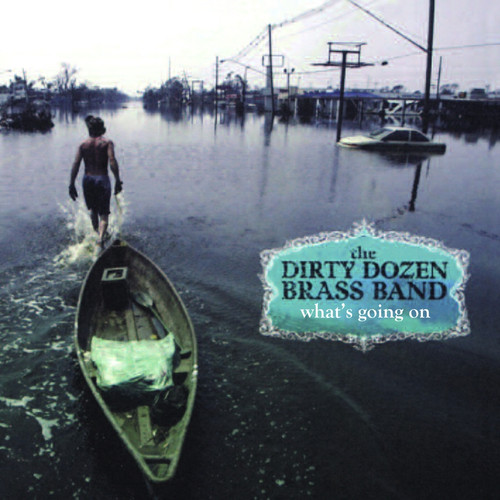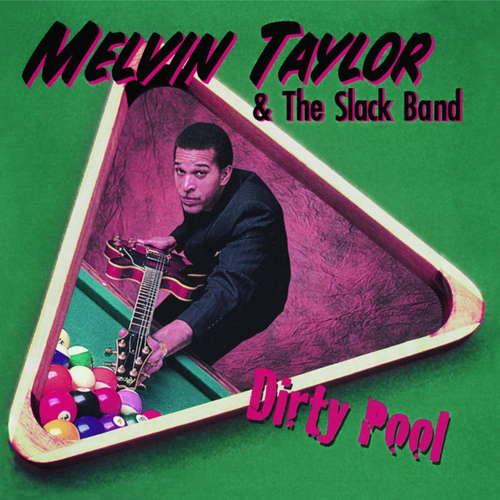In 2006, exactly a year after Katrina, in the aftermath of a vicious natural disaster that displayed the incompetence of the Crescent City's infrastructure, the Army Corps of Engineers, and the Federal Government, they addressed the tragedy in the only way they know how, by re-creating the same kind of bewilderment and anger that Marvin Gaye felt and witnessed in 1971 by issuing their own take on Gaye's classic album "What's Goin' On". This is a question that is proved all the more poignant given the efforts of an entire region trying not only to rebuild homes and businesses, but trying to preserve a culture as this recording was released. The Dirty Dozen recruit a number of vocalists to help out on the hinge tunes. The samples of New Orleans Mayor Ray Nagin's voice in the aftermath of the hurricane usher in the brass slip-sliding along the dark funky overtones of Gaye's signature tune. Guitarists Doug Bossi and Ben Keeler dig into the groove, as does drummer Terence Higgins and keyboardist/producer Anthony Marinelli, as Chuck D raps the refrain in the context of modern history, the disaster, and the ineptitude and even hostility of a government who wages war and ignores domestic problems. It's a news report from the front lines as the horns cut the melody, the harmony, and the deep, steamy funk groove. "What's Happening Brother", closes the funk from the inside, turning the groove back in on itself not only playing the rage, but echoing it in the grain of Bettye LaVette's vocal, which dares to spit out the truth with questions and observations in the pain of a first person narrative. The airy arrangement of "Flyin' High (In the Friendly Sky)" is nearly mournful, nostalgic for a more innocent time, but is all the more poignant for that longing. The deep tribal drums Mardi Gras Indian-style, with the skronky saxophones, tight guitar groove, and screaming narrative in "Save The Children" give way to the smoothness of Gaye's melody. It's a bewildered tune, sad with undercurrents of rage. Ivan Neville's arrangement for "God Is Love" is a stunner, full of deeply imaginative hues and colors and gospel grooves. G. Love helps out on "Mercy Mercy Me (The Ecology)", where the musicality in Gaye's vocal disappears but is supercharged in the horn charts, and Love's vocal sounds confused, displaced, out of time against the instruments. "Right On" is both militant and celebratory. It's got the funk, but it's also got gospel, rock, and deep soul blaring from the trombones and the repetitive riff in the rest of the brass section. Guru from Gang Starr cuts out from the moody, spectral introduction of "Inner City Blues", when Higgins drums play counter to Kirk Joseph's deep blues sousaphone on the bassline. Frustration is everywhere and the horns point fingers to this truth which Guru lays out: that today is the same and perhaps even more so than it was in Gaye's time. The desolation in Gaye's lyric isn't lost but it is fleshed out over the chart so that they are merely the ghosts from the past preaching and exhorting in this new generation. Never has party music sounded so poignant, so utterly damning and hopeful and unbowed. This is the next step in the Homecoming that was a funeral for a friend; this is the aftermath, the sound of angry resurrection coming out with the sun, one where the revolution may be televised but bursts out of the edges in the screen and makes itself known by the medium understood by the people who have to live its realization. With killer grooves that take no prisoners, "What's Goin' On" is the most fitting tribute yet to Gaye, because not only does it prove the timelessness of the music itself, it echoes that what is indeed goin' on (Gaye's dedication to Detroit as its decline became a reality with no onlookers interested in doing anything) is even more true today than it was in 1971.
2006, genau ein Jahr nach "Katrina", in der Zeit nach der bösen Naturkatastrophe, die sowohl die Inkompetenz der Infrastuktur der Stadt, die den Beinamen Crescent City trägt, zeigte, als auch die des Armeekorps, der Ingenieure und der Bundesregierung, in dieser Zeit also widmete sich die Dirty Dozen Brass Band der Tragödie in der einzigen Art und Weise, die sie kennen, indem sie die gleiche Art von Verwirrung und Wut wiedererschufen, die Marvin Gaye 1971 fühlte und ausdrückte, dadurch, dass sie ihre eigene Interpretation von Gaye's Klassiker "What's Goin' On" vorstellten. Das ist eine Frage, die sich als umso schmerzlicher erweist, wenn man die Anstrengungen - zu dem Zeitpunkt, als diese Aufnahme veröffentlicht wurde - einer ganzen Region betrachtet, die sich nicht nur bemüht, Wohnhäuser und Geschäfte wiederaufzubauen, sondern versucht, eine Kultur zu bewahren. The Dirty Dozen rekrutierte etliche Sänger, um bei den tragenden Songs auszuhelfen. Ausschnitte von Ansprachen vom Bürgermeister von New Orleans, Ray Nagin, nach dem Hurrikan bilden die Einleitung für die Blechbläser, die an den dunklen, funkigen Zwischentönen von Gayes Titelmelodie entlanggleiten. Die Gitarristen Doug Bossie und Ben Keeler wühlen sich in den Groove, genau so wie Schlagzeuger Terence Higgins und der Keyboardspieler und Produzent Anthony Marinelli, während Chuck D den Refrain rappt bezogen auf die Zeitgeschichte und die Katastrophe sowie die Unfähigkeit bzw. sogar Feindseligkeit einer Regierung, die in einen Krieg zieht und Probleme im eigenen Land ignoriert. Wie ein Bericht von der Front zerschneiden die Bläser die Melodie, die Harmonie und den tiefen dampfenden Funk-Groove. "What's Happening Brother" sperrt den Funk vom Inneren ab, wirft den Groove auf sich selbst zurück und spielt nicht nur Wut, sondern bietet auch ihr Echo in Gestalt von Bettye LaVettes Gesang, der die Wahrheit herauszuspeien wagt samt den Fragen und Beobachtungen voller Schmerzen einer Ich-Erzählerin. Das leichte Arrangement von "Flyin' High (In the Friendly Sky)" ist beinahe traurig, voller Sehnsucht nach einer unschuldigeren Zeit, gleichzeitig aufgrund dessen umso ergreifender. Die tiefen Eingeborenen-Trommeln im indianischen Mardi-Gras-Stil mit den heiseren Saxophonen, den kompakten Gitarren-Grooves und der schrillen Erzählung in "Save The Children" weichen der Sanftheit von Gaye's Melodie. Es ist ein verwirrtes Lied, traurig mit Unterströmungen der Wut. Ivan Nevilles Arrangement von "God Is Love" ist eine Wucht, voller erfindungsreicher Schattierungen und Farben und Gospel-Grooves. G. Love hilft bei "Mercy Mercy Me (The Ecology)" aus, bei dem die Musikalität von Gayes Gesang verschwindet, aber von den Bläsern aufgeladen wird, und Loves Gesang klingt verworren, versetzt, unzeitgemäß gegenüber den Instrumenten. "Right On" ist sowohl militant als auch feierlich. Es steckt Funk drin, aber auch Gospel, Rock und tiefes Soul-Geschmetter der Posaunen und dem sich wiederholenden Riff der übrigen Blechbläser. Guru von Gang Starr sticht hervor aus der düsteren, geisterhaften Einleitung zu "Inner City Blues", bei der Higgins Schlagzeug Kirk Josephs tiefes bluesiges Sousaphon beim Bass kontrapunktiert. Überall Frustration und die Bläser zeigen mit dem Finger auf diese Wahrheit, die Guru erläutert: das alles heutzutage genauso ist wenn nicht noch heftiger als zu Gayes Zeiten. Die Trostlosigkeit in Gayes Text geht nicht verloren, sondern wird im weiteren Verlauf untermauert, so dass nur noch Gespenster bleiben von verausgegangenen Predigten und den Ermahnungen für diese neue Generation. Nie hat Party-Musik so heftig geklungen, so total verdammend und hoffnungsvoll und ungebeugt. Das ist der nächste Schritt im Leichenzug, wo es um die Beerdigung eines Freundes geht; das ist das Nachspiel, der Klang erboster Wiederauferstehung, die mit der Sonne hervorkommt, etwas, das im Fernsehen gezeigt werden mag, aber aus dem Rand des Bildschirms hervorquillt und sich durch das Mittel bekannt macht, das von den Leuten verstanden wird, die seine Verwirklichung erleben müssen. Mit Killer-Grooves, die keine Gefangenen machen, ist "What's Goin' On" der passendste Tribut von Allen an Gaye, weil er nicht nur die Zeitlosigkeit der Musik selbst zeigt, sondern das widerpiegelt, was tatsächlich los ist (Gayes Einsatz für Detroit, als der Niedergang der Stadt Wirklichkeit wurde, mit Zuschauern, die keinerlei Interesse daran hatten, irgend etwas zu unternehmen), ist heutzutage noch wahrhaftiger als 1971.










